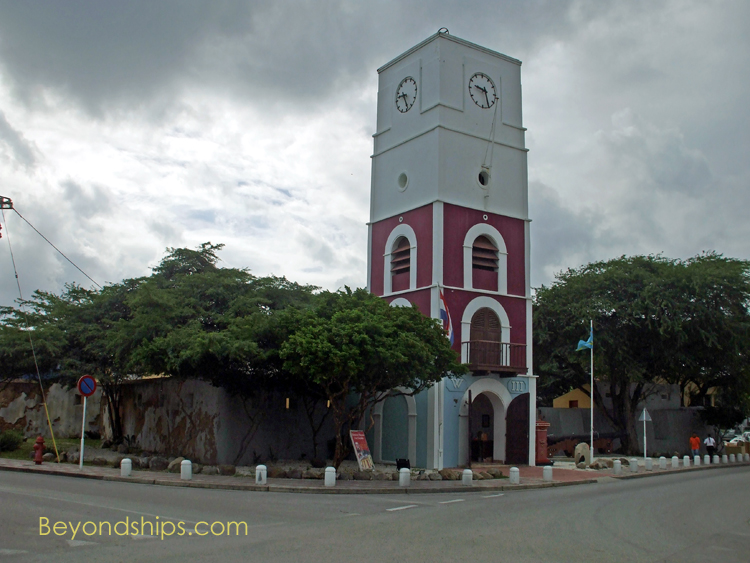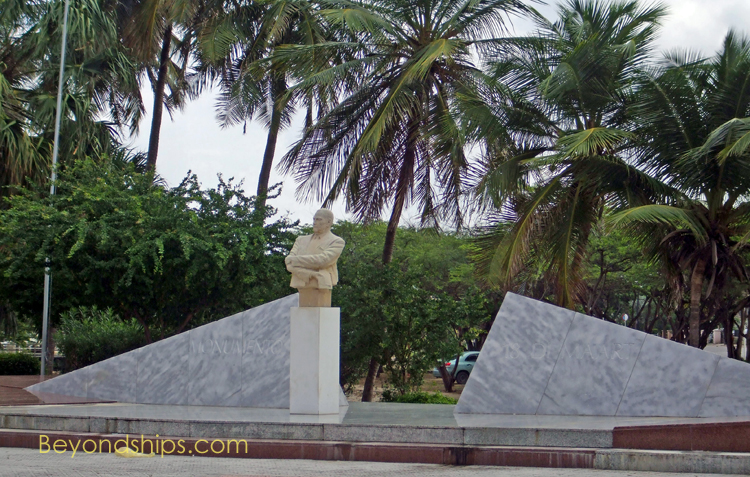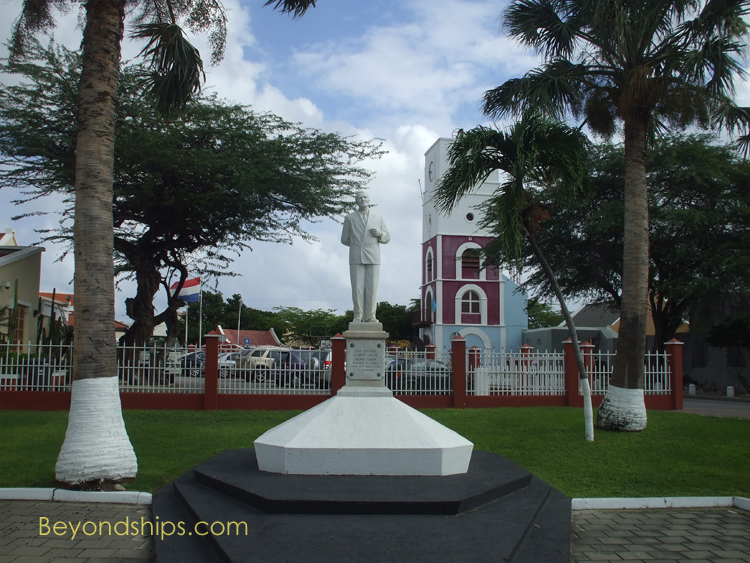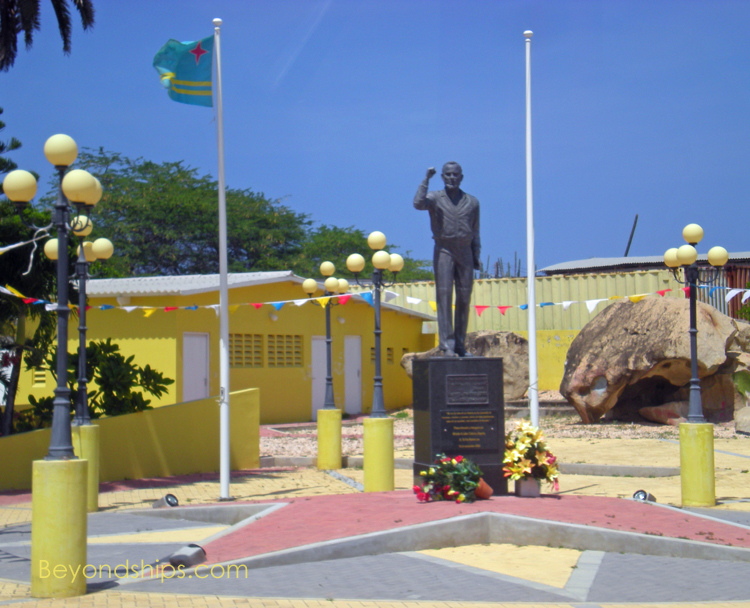|
CRUISING TO THE CARIBBEAN:
ARUBA HISTORY |
Above: Fort Zoutman, built in 1796 to defend Oranjestad
is one of the island's oldest buildings. The tower added in 1868 is named after the Dutch King Willem III. Today, the fort houses Aruba's historical museum as well as a numismatic museum with a collection of coins and money from over 400 countries. |
|
There are traces of human life in Aruba dating back 4,500
years. However, the earliest known inhabitants were the Caquetio Indians of the Arawak tribe from the South America. They appear to have come to the island around 2,500 B.C. and were first fishermen and hunters and later farmers. Although they did not live in the caves, the Caquetios also made cave paintings, some of which survive to this day. In the fourteenth century, they were conquered by the Carib Indians. It is disputed whether the first European to arrive on the island was Alonso de Ojeda or by Amerigo Vespucci However, by 1500, the Spanish had visited Aruba, calling it a land of giants because of the size of the Indians that they encountered. Terming the island “useless,” in 1513, the Spanish enslaved the entire Indian population and removed them to work in the copper mines on Hispaniola (now the Dominican Republic). This left the island uninhabited. However, some of the Indians were allowed to return to Aruba in 1515 and together with Indians who had moved to the island from the mainland, they built villages in the northern part. But the Spanish also returned to Aruba a few years later and set up a horse and cattle ranch. Once again, the Indians were pressed into service as workers on the ranch. Spanish control of Aruba was not to last too much longer. By the seventeenth century, the Dutch had developed a thriving herring industry. In order to preserve the herring, the Dutch used salt, which they obtained from Spain. However, by the early 1600s, relations between the Netherlands and Spain had deteriorated into war. As a result, the Dutch had to look for other sources of salt, one of which was Venezuela. To protect this source and to set up a base of operations in the Southern Caribbean, the Dutch captured Curacao in 1634. Two years later, the Dutch captured Bonaire and Aruba, in order to protect their new base in Curacao. The arrival of the Dutch in Aruba was good news for the Indians. While the island continued to be used for raising horses, goats and other livestock, the Dutch prohibited white settlement on the island except for soldiers. Consequently, the Indians lived in relative freedom, going about their own business while keeping watch over the government’s cattle. Towards the end of the eighteenth century, Aruba became a Dutch colony. The town of Oranjestad developed as a trading center and became a layover port for ships bound for Curacao. Aruba’s arid climate made the island unsuitable for plantations. As a result, the African slave trade that took place on so many Caribbean islands in the eighteenth century never came to Aruba. During the nineteenth century gold and phosphate were mined on Aruba. In addition, the aloe plant was brought to Aruba and a thriving aloe industry was born. In the 1920s the oil industry came to Aruba. Nearby Venezuela is a major source of oil. However, the oil companies needed a place where the oil could be transshipped from the shallow draft tankers that could sail on Venezuela’s Lake Maracaibo onto deep draft ocean-going tankers. Aruba’s proximity to Venezuela made it an attractive location. Also, since the oil was going to be taken off the lake tankers there, why not build refineries to process the oil before putting it on the ocean tankers? Accordingly, the Eagle refinery was built west of Oranjestad and the Lago refinery was built near San Nicolas at the eastern end of the island. The coming of the oil industry produced an economic boom. People came from America, Europe, South America and throughout the Caribbean to work at the refineries. There was a great deal of construction and the standard of living increased dramatically. While the Eagle refinery closed during World War II, the Lago refinery continues to operate although it has changed ownership several times. Right: The statue of Betico Croes, who brought about
Aruba's separate status within the Kingdom of the Netherlands. Called the "liberator", his birthday is a national holiday in Aruba. |
Because of its oil refineries, Aruba played an important role
in World War II. The Lago refinery was at that time one of the world’s largest and the products it produced fueled the Allied armies and air forces. In recognition of its importance, Dutch, French, British and American troops were sent to guard the island. The Germans also recognized its importance. On 16 February 1942, the submarine U-156 arrived off Aruba and found not only tankers but ammunition ships moored there. Firing its torpedoes the submarine set several ships ablaze, lighting the night sky. However, the real prize was the Lago refinery, which it found well-lit and essentially undefended. Surfacing, U-156 readied its heavy deck gun to bombard the refinery. Such a cannon was capable of doing great damage to the refinery and thus to the Allied war effort. However, in their enthusiasm, the gun crew forgot to remove the watertight plug that protected the barrel of the cannon when the sub was submerged. As a result, when they fired, the U-Boat’s cannon rather than the refinery exploded. In the post war period, the pressure for self-determination in Aruba grew. In a speech in 1942, Queen Wilhelmina had promised autonomy to the Dutch colonies. Accordingly, in 1948, a constitution was issued under which an autonomous country consisting of the ABC Islands, Sint Eustatius, Sint Maartin and Saba was issued. The new country was called the Netherlands Antilles and would remain a part of the Kingdom of the Netherlands. The new arrangement did not satisfy the people of Aruba. It was felt that Curacao would dominate the new country and that Aruba should be free to decide its own course. This led to demands for either independence or a separate status for Aruba apart from the Netherlands Antilles within the Kingdom of the Netherlands. Following strikes and demonstrations in the 1980s in Aruba, a conference was held in which it was decided that Aruba would secede from the Netherlands Antilles and from January 1, 1986 until January 1, 1996, it would be an autonomous country within the Kingdom of the Netherlands. Following that, Aruba would become independent. Aruba found, however, that it liked its “Status Aparte” within the Kingdom of the Netherlands and so in 1990, it was decided that the country would not go forward with plans for complete independence. Above: The Monument to 18 March. On 18 March 1948, Shon
Eman presented a petition to the Queen of the Netherlands signed by 2,147 Arubans insisting on self-determination for Aruba. The monument has the names of all the signers of the petition. 18 March is Aruba's national day. Below: A statue of Henry Eman, who was an early leader on the self-determination movement. |
|
|
|
Cruise destination travel guide - Aruba - Aruba history



